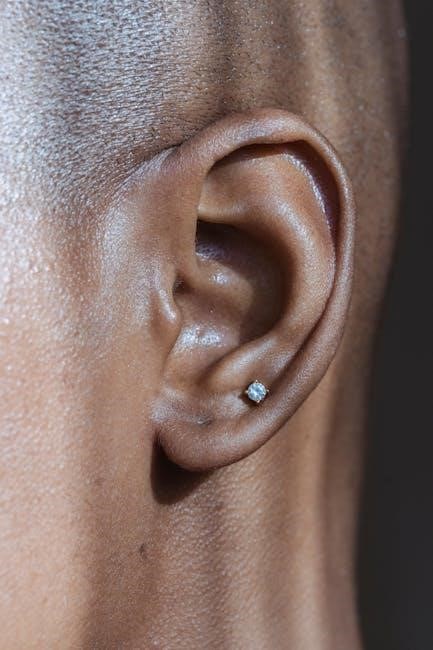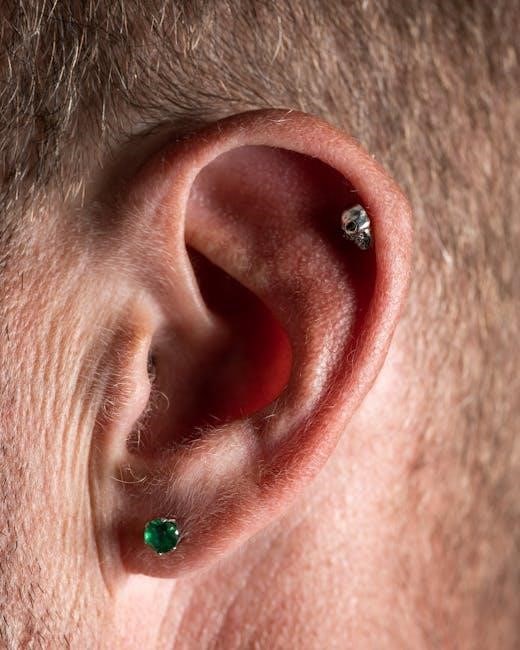
Understanding ear piercing sizes is crucial for a comfortable fit, and a size guide helps visualize the different gauges and measurements, making it easier to choose the right size for your piercing, with standard sizes usually 20g or 18g.
Understanding Gauge Sizes
Gauge sizes are a crucial aspect of ear piercing, and it is essential to understand the different sizes to make an informed decision. The gauge system is used to measure the thickness of the piercing jewelry, with higher gauge numbers indicating thinner jewelry. The most common gauge sizes for ear piercings are 18g, 16g, and 14g, with 18g being the thinnest and 14g being the thickest. Gauge sizes go up in even numbers, and after 00g, sizes are referred to in millimeters or fractions of an inch. A comprehensive understanding of gauge sizes is necessary to choose the right size for your piercing, and a size guide can help visualize the different gauges and measurements. By understanding gauge sizes, individuals can make informed decisions about their piercings and choose the right jewelry to ensure a comfortable and secure fit.

Ear Piercing Gauge Size Chart
A chart helps compare gauge sizes, millimeters, and inches, making it easier to choose the right size for your piercing with standard sizes usually 20g or 18g always available online.
Common Ear Gauge Piercing Sizes
The most common ear gauge piercing sizes are 18 gauge, 16 gauge, and 14 gauge, these sizes are popular due to their versatility and comfort. A table or chart can help visualize the conversion between gauge sizes, millimeters, and inches, making it easier to choose the right size for your piercing. Standard ear piercings are usually pierced at 20g or 18g, which is approximately 1mm, and gauge sizes go up in even numbers from there. The size you choose depends on your personal preferences and the type of jewelry you want to wear. Some people prefer smaller gauges, while others prefer larger ones, it’s all about finding the right size that suits your style and comfort level. A detailed chart can aid in visual comparison of sizes, and actual real-life pictures can also be helpful in determining the right size for your piercing.

Choosing the Right Size for Your Piercing
Consider your lifestyle and personal style when selecting a piercing size, ensuring a comfortable fit with the right jewelry, for optimal results and satisfaction always.
Initial Piercings and Stretching
When getting an initial piercing, it’s essential to consider the size and type of jewelry to be used, as well as the aftercare instructions to ensure proper healing. The piercing process typically involves using a needle to create a hole, and then inserting the jewelry. For those looking to stretch their piercings, it’s crucial to do so gradually to avoid damaging the skin or causing discomfort. A common method is to increase the gauge size in small increments, allowing the skin to adjust before moving to the next size. This process can take time and patience, but with proper care and attention, it’s possible to achieve the desired size and style. Using high-quality jewelry and following proper aftercare techniques can help minimize the risk of complications and promote healthy healing. By understanding the process and taking the necessary precautions, individuals can enjoy their piercings and maintain good overall health.

Ear Piercing Jewelry Size Guide
Jewelry sizes vary, with post lengths and hoop diameters available to suit different ear types and styles perfectly always.
Post Length and Hoop Diameter
When it comes to choosing the right jewelry for your ear piercing, post length and hoop diameter are essential factors to consider. The post length refers to the length of the barbell or post that goes through the piercing, and it is crucial to select a length that is comfortable and suitable for your ear type. A post that is too long can cause discomfort and irritation, while a post that is too short may not provide enough support for the jewelry. On the other hand, the hoop diameter refers to the size of the hoop or ring that is used in the piercing. Hoop diameters can vary, and it is essential to choose a size that is proportionate to the size of your ear and the type of piercing you have. By considering these factors, you can ensure that your jewelry is comfortable and secure, and that it enhances the overall appearance of your piercing. Proper measurement is key to a perfect fit, and using a jewelry size guide can help you determine the ideal post length and hoop diameter for your ear piercing.

Ear Piercing Types and Placements
Various ear piercing types include lobe, helix, and tragus, each with unique placement considerations and styling options available for individuals to choose from and express themselves.
Healing Times and Aftercare
Proper aftercare is essential for ear piercings to heal quickly and minimize the risk of complications; The healing time for ear piercings can vary depending on the location and individual factors. Generally, earlobe piercings take around 6-8 weeks to heal, while cartilage piercings can take 3-6 months. It is crucial to follow a consistent aftercare routine, which includes cleaning the piercing with saline solution and avoiding tight clothing that may irritate the area. A well-informed aftercare plan can help prevent common issues such as redness, swelling, and infection. By prioritizing aftercare, individuals can ensure a smooth healing process and enjoy their ear piercings for years to come. Regular check-ups with a piercing professional can also provide valuable guidance and support during the healing period. With proper care and attention, ear piercings can be a beautiful and lasting form of self-expression. Effective aftercare is key to a successful piercing experience.